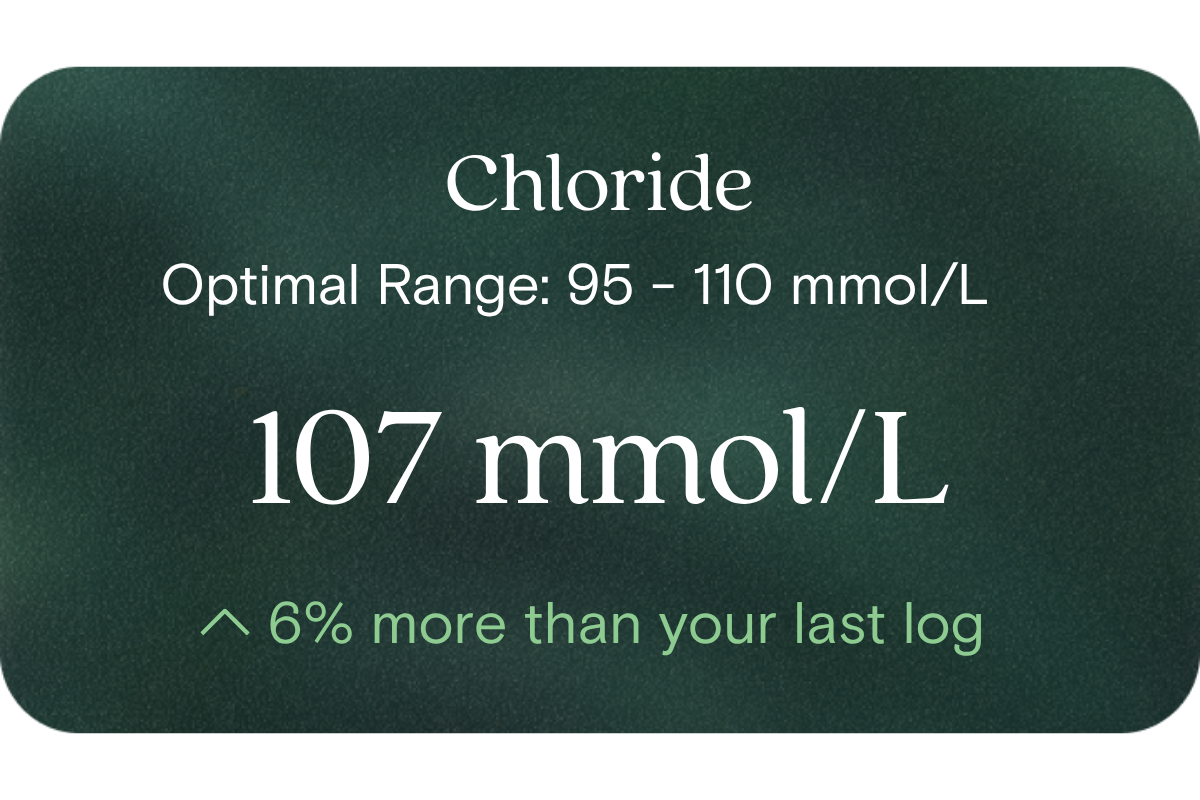What is Chloride?
Chloride is a negatively charged electrolyte (anion) that works alongside positively charged ions such as sodium and potassium. In blood plasma, it helps maintain charge balance, supports fluid distribution between compartments, and contributes to acid–base regulation. As one of the more abundant electrolytes in serum, chloride is integral to core physiological balance.
Why does it matter for long-term health and wellbeing?
While we rarely think about it, chloride plays a silent but essential role in preserving internal stability. Proper chloride levels help sustain effective fluid balance, efficient waste removal, and pH control — which all influence energy efficiency, metabolic flexibility, and tissue function over time. Tracking chloride trends can reveal subtle imbalances before they manifest more broadly, so you can intervene early rather than react to downstream effects.
What’s an optimal level of Chloride?
- Optimal (Vively target): 95 to 110 mmol/L
- Standard laboratory reference range: 95 to 110 mmol/L. If your result is within that 95–110 mmol/L window, it is considered well aligned with optimal physiological balance.
What influences Chloride levels?
Several factors can push chloride up or down, including:
- Hydration status: Dehydration or overhydration shifts electrolyte concentrations
- Salt (sodium chloride) intake: Dietary salt contributes to chloride balance
- Kidney function: Kidneys reabsorb or excrete chloride in close coordination with sodium and bicarbonate mechanisms
- Acid–base shifts: Changes in acid or alkaline load (e.g. from diet, breathing, metabolism) alter chloride and bicarbonate interplay
- Sweat and losses: During high heat or strenuous exercise, chloride is lost with sweat, which can shift balance if not replaced
What does it mean if Chloride is outside the optimal range?
A chloride result above or below 95–110 mmol/L doesn’t by itself diagnose anything, but it signals that underlying fluid, electrolyte or acid–base balance may be shifted. For example:
- Below optimal: you might be relatively “diluted,” or you may have excess bicarbonate or low salt load
- Above optimal: you may be relatively “concentrated,” or there may be a shift in acid load or retention of chloride
In both cases, it’s a guidepost to re-evaluate hydration, diet, and related electrolytes (like sodium, potassium, bicarbonate) — ideally before symptoms or performance impacts emerge.
How can I support healthy Chloride levels?
Here are lifestyle adjustments to help maintain or nudge chloride into optimal alignment:
- Maintain consistent and adequate hydration (avoid wide swings in fluid intake)
- Moderate salt consumption (not extremes of very low or very high) with unprocessed or whole-food sources
- Support kidney and metabolic health through good sleep, stress management, and avoiding unnecessary added burdens
- During heat exposure or heavy sweating, ensure electrolytes (including chloride) are replenished appropriately
- Monitor related biomarkers (sodium, potassium, bicarbonate) so chloride doesn’t act in isolation
This information is provided for general health and wellness purposes only and does not replace medical advice.
References
- Berend, K., van Hulsteijn, L. H., & Gans, R. O. (2012). Chloride: the queen of electrolytes? European Journal of Internal Medicine.
- Yunos, N. M., et al. (2011). The biochemical effects of restricting chloride-rich fluids in a tertiary intensive care unit in Australia. Critical Care Medicine.
- “Bench-to-bedside review: Chloride in critical illness.” (2010). Critical Care.
- El-Sharkawy, A. M., et al. (2014). The pathophysiology of fluid and electrolyte balance in older adults. Nutrition and Health.




















.png)
